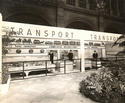 Car ownership in Glasgow has always been comparatively low, but most postwar transport planning for the city followed the norm as elsewhere in Britain by assuming that additional roads would be needed to cope with growing motor traffic.
Car ownership in Glasgow has always been comparatively low, but most postwar transport planning for the city followed the norm as elsewhere in Britain by assuming that additional roads would be needed to cope with growing motor traffic.
 The first strategic addition to the city's road system was the Clyde Tunnel, completed in 1964. The following year, the Highway Plan for Glasgow proposed an inner ring motorway round the city centre fed by radial motorways or expressways. Two partial ring motorways further out from the centre would have enabled through traffic to avoid central Glasgow.
The first strategic addition to the city's road system was the Clyde Tunnel, completed in 1964. The following year, the Highway Plan for Glasgow proposed an inner ring motorway round the city centre fed by radial motorways or expressways. Two partial ring motorways further out from the centre would have enabled through traffic to avoid central Glasgow.
 Some of these proposals encountered strong opposition when the Corporation sought to implement them, especially the planned conversion of Great Western Road into an expressway and the route of the east flank of the inner motorway through Glasgow Green. So although the opening of the Kingston Bridge in 1970 completed the north and west flanks of the inner ring road, creating a motorway route right through the city, most of the other proposals remained stalled and were largely abandoned by Strathclyde Regional Council after it became the city's roads authority in 1974. The only subsequent additions to the city's motorways were the M77 and M80 spurs, linking the trunk routes from Ayr and Stirling directly into the existing M8. Some other roads, such as Cowcaddens Road, were improved as part of local redevelopment schemes.
Some of these proposals encountered strong opposition when the Corporation sought to implement them, especially the planned conversion of Great Western Road into an expressway and the route of the east flank of the inner motorway through Glasgow Green. So although the opening of the Kingston Bridge in 1970 completed the north and west flanks of the inner ring road, creating a motorway route right through the city, most of the other proposals remained stalled and were largely abandoned by Strathclyde Regional Council after it became the city's roads authority in 1974. The only subsequent additions to the city's motorways were the M77 and M80 spurs, linking the trunk routes from Ayr and Stirling directly into the existing M8. Some other roads, such as Cowcaddens Road, were improved as part of local redevelopment schemes.
 One major benefit from the completion of the M8 through Glasgow was the diversion of traffic from existing streets. This has allowed the main commercial streets in the city centre to be pedestrianised, starting with Buchanan Street in 1978.
One major benefit from the completion of the M8 through Glasgow was the diversion of traffic from existing streets. This has allowed the main commercial streets in the city centre to be pedestrianised, starting with Buchanan Street in 1978.